Greetings, fellow food enthusiasts! Today, I want to dive into the fascinating world of transporting fruit and vegetables. It may seem like a simple task, but it involves a complex web of logistics and considerations to ensure that those vibrant, ripe produce reach our plates in their freshest form.
From the moment they leave the farm to the time they arrive at our local grocery stores, every step in the process matters. As we delve into the intricacies of fresh produce transportation, we’ll explore the importance of efficient logistics, the challenges faced, and the best practices for keeping our fruits and vegetables in top-notch condition.
Whether it’s shipping perishable goods across the country, managing the cold chain logistics, or maintaining temperature-controlled transportation, the goal is to minimize wastage and maintain product quality throughout the food supply chain.
Join me as we uncover the secrets behind transporting fruits and vegetables safely, and discover how these practices impact our overall food experience.
Key Takeaways:
- Transporting fresh produce involves intricate logistics and considerations.
- Efficient transportation is essential for maintaining the freshness and quality of fruits and vegetables.
- Fruit and vegetable transportation faces challenges such as natural delays and short shelf life.
- Proper packaging and temperature control are crucial to ensure the safety and freshness of the produce.
- The future of fresh produce logistics lies in sustainability and digitization.
Challenges of Shipping Fruits and Vegetables
Shipping fruits and vegetables comes with a unique set of challenges due to their perishable nature. Timely processing and shipping are crucial to ensure the produce remains fresh. Any delays can result in a decrease in quality and freshness, impacting customer satisfaction.
Natural delays, such as weather disasters, can pose additional risks to the freshness of the fruits and vegetables during transit. These unforeseen circumstances can disrupt the supply chain and cause delays, leading to potential wastage and financial losses.
Furthermore, fresh produce has a relatively short shelf life, and it spends a significant portion of that time in transit. The time-sensitive nature of shipping fruits and vegetables necessitates efficient logistics and transportation practices to ensure that the produce reaches its destination while still at its peak freshness and quality.
Communication difficulties can also present challenges in the shipping process. Effective coordination between suppliers, transporters, and receivers is essential to prevent miscommunication, delays, or shortages of the produce. Clear communication channels and constant updates are imperative to overcome these hurdles and maintain smooth operations throughout the supply chain.
To address these challenges, it is crucial for stakeholders in the fruit and vegetable shipping industry to implement efficient and reliable logistical processes, establish contingency plans for natural delays, and ensure effective communication channels are in place.
Shipping fresh produce comes with a range of challenges that require careful consideration and strategic planning. By understanding and addressing these challenges, the industry can optimize the transportation of fruits and vegetables, ensuring that they reach consumers in the freshest possible state.
Packaging Fruits and Vegetables for Shipping
Proper packaging is essential to protect and preserve fruits and vegetables during shipping. When it comes to packaging fresh produce, cartons made from fibreboard blanks provide durability and strength. These cartons have proven to be effective in safeguarding the fruits and vegetables from external damage during transit.
One crucial aspect of packaging is ensuring proper ventilation. Fruits and vegetables require adequate airflow to prevent moisture buildup, which can lead to decay and spoilage. Cartons with ventilation holes allow for the circulation of fresh air, maintaining the freshness of the produce throughout the shipping process.
Labeling requirements are another important consideration when packaging fruits and vegetables for shipping. Clear and accurate labeling ensures that packages can be easily identified and handled correctly. Labeling should comply with regulatory guidelines, providing important information such as product name, weight, and any necessary handling instructions.
Proper packaging is the first line of defense in ensuring that fresh produce reaches its destination in optimal condition. From sturdy cartons to proper ventilation and labeling, each aspect plays a crucial role in preserving the quality and freshness of fruits and vegetables during shipping.
The Benefits of Carton Packaging for Fresh Produce
Carton packaging offers several advantages when it comes to transporting fresh fruits and vegetables:
- Protection: Fibreboard cartons provide a sturdy and protective barrier, shielding delicate produce from external impact and preventing bruising or crushing.
- Moisture control: Properly ventilated cartons help regulate moisture levels, preventing the buildup of excess moisture that can lead to spoilage or rot.
- Stackability: Cartons are designed for easy stacking, maximizing space utilization during shipping and storage.
- Recyclability: Cartons made from fibreboard are recyclable, offering an eco-friendly packaging option that aligns with sustainable practices.
By utilizing carton packaging with appropriate ventilation and labeling, producers and distributors can ensure that fruits and vegetables maintain their freshness and quality while being transported to their intended destinations.
Labeling Requirements for Fresh Produce Packaging
Accurate labeling is essential for proper handling and identification of packaged fruits and vegetables. While specific labeling requirements may vary depending on regulatory guidelines, some common information to include on the labels are:
- Product name: Clearly state the name of the fruit or vegetable being packaged.
- Weight or quantity: Provide the weight or quantity of the produce contained in the package.
- Handling instructions: Include any specific instructions for handling the produce during transportation and storage.
- Origin: Indicate the origin of the produce, providing transparency for consumers and compliance with import/export regulations.
- Expiration date (if applicable): If the produce has a limited shelf life, include the expiration date to ensure freshness.
By following proper labeling requirements, producers and distributors can enhance traceability, facilitate inventory management, and ensure consumer confidence in the freshness and safety of the fruits and vegetables they purchase.
The Role of Reefers in Fruit and Vegetable Transportation
When it comes to transporting perishable fruits and vegetables, refrigerated trailers, commonly known as reefers, play a vital role. These specialized trailers enable temperature-controlled transportation and ensure the freshness and quality of the produce throughout the journey.
One of the key features of reefers is their ability to circulate fresh air. This helps maintain the optimal temperature and humidity levels necessary for preserving the fruits and vegetables. By providing continuous fresh air circulation, reefers prevent the buildup of gases that can cause premature spoilage. This fresh air exchange is crucial for extending the shelf life of the produce and ensuring it reaches its destination in pristine condition.
Reefers consist of various components that work together to maintain temperature control and ventilation. These components include condensers, fans, fresh air vents, unit evaporators, and control units. The condensers and evaporators regulate the temperature inside the trailer, while the fans ensure even air distribution. The fresh air vents allow for the entry of fresh air, while the control units monitor and maintain the desired temperature range.
Components of Reefers
To further understand the important role of reefers in fruit and vegetable transportation, let’s take a closer look at the various components:
| Component | Description |
|---|---|
| Condensers | Remove heat from the trailer by compressing the refrigerant and facilitating its heat exchange. |
| Fans | Circulate the air inside the trailer, ensuring even distribution of temperature and humidity. |
| Fresh Air Vents | Allow for the entry of fresh air, maintaining proper gas exchange and preventing buildup of harmful gases. |
| Unit Evaporators | Evaporate refrigerant to cool the air inside the trailer, thus maintaining the desired temperature range. |
| Control Units | Monitor and regulate the temperature and humidity, ensuring precise control and adjustments when needed. |
With these components working in harmony, reefers provide the ideal environment for transporting fruits and vegetables. The temperature-controlled system, fresh air circulation, and gas exchange capabilities of reefers make them indispensable for maintaining the freshness, quality, and safety of perishable produce.
Importance of Temperature Control in Fruit and Vegetable Shipping
Temperature control is an essential aspect of fruit and vegetable shipping to ensure the freshness and quality of the produce. Maintaining the optimal temperature range is crucial for preserving the flavor, texture, and nutritional value of fruits and vegetables. Incorrect temperature management during transportation can have a significant impact on the freshness and shelf life of the produce.
Different types of fruits and vegetables have specific temperature requirements for optimal storage. Failure to meet these temperature ranges can result in accelerated ripening, premature spoilage, and loss of quality. Let’s take a closer look at the temperature ranges for some commonly shipped produce:
| Produce | Temperature Range (°C) |
|---|---|
| Apples | -1.11 to 4.44 |
| Bananas | 13.33 to 14.44 |
| Lettuce | 1.67 to 4.44 |
| Tomatoes | 12.78 to 15.56 |
Maintaining the ideal temperature range not only extends the shelf life of the produce but also helps minimize spoilage, discoloration, and texture changes. It ensures that consumers receive fruits and vegetables that are fresh, flavorful, and visually appealing.
Controlling the temperature during shipping requires reliable refrigerated trailers, also known as reefers. These specialized vehicles provide the necessary insulation and cooling mechanisms to maintain the desired temperature range. Proper ventilation and air circulation within reefers prevent temperature fluctuations and ensure uniform cooling throughout the cargo.
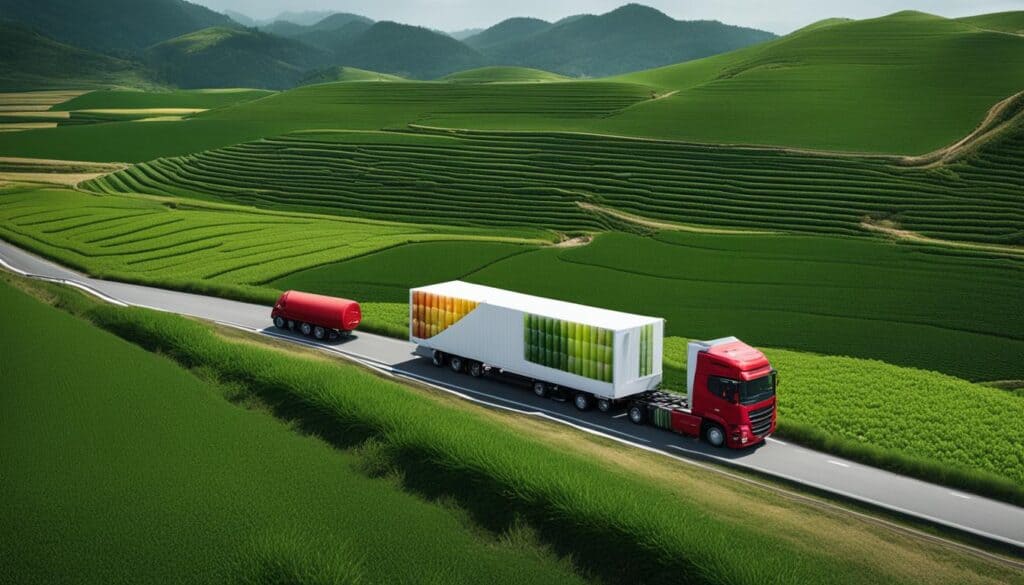
By prioritizing temperature control in fruit and vegetable shipping, businesses can optimize the freshness and quality of their produce, resulting in increased customer satisfaction and reduced waste. It is essential to work closely with logistics partners to establish temperature monitoring systems and implement best practices for temperature-controlled transportation.
Tips for Temperature Control in Fruit and Vegetable Shipping:
- Regularly calibrate and maintain temperature monitoring equipment.
- Pre-cool fruits and vegetables before loading them into refrigerated trailers.
- Ensure proper airflow and distribution of produce within the trailer.
- Monitor and record temperature data throughout the shipping process.
- Train and educate staff on temperature control protocols and best practices.
Proper temperature control is not just essential for maintaining the freshness of fruits and vegetables but also for meeting regulatory requirements and ensuring consumer safety. It is a critical aspect of the entire cold chain logistics process, from farm to table.
By prioritizing temperature control, businesses can deliver high-quality fruits and vegetables that satisfy consumer demands for fresh and nutritious produce throughout the year.
Challenges and Developments in Fresh Produce Logistics
Transporting fresh produce presents a unique set of challenges in logistics. From reducing waste to adhering to quality regulations, the industry strives to maintain a good business reputation while meeting consumer demands. As the global fresh food market continues to grow, reaching nearly 4 billion USD by 2027, it becomes imperative for the industry to embrace new technologies and trends for improved efficiency. Some of the key challenges and developments in fresh produce logistics include:
Reducing Waste in Transportation
The transportation of fresh produce often results in significant waste due to various factors such as spoilage, mishandling, and improper packaging. To combat this, businesses are adopting innovative solutions like implementing enhanced cold chain processes and investing in state-of-the-art refrigerated transportation. Through advanced temperature control and monitoring systems, the industry aims to minimize waste and maximize product quality.
Quality Regulations and Business Reputation
Quality regulations play a crucial role in fresh produce logistics. Compliance with these regulations not only ensures the safety and quality of the produce but also safeguards the business reputation. Stringent quality control measures, such as proper handling, storage, and labeling, are essential to meet regulatory standards and maintain consumer trust.
Trends in Fresh Produce Logistics
The fresh produce logistics industry is undergoing a digital transformation. With the digitization of the food supply chain, businesses can gain real-time visibility, optimize routes, and improve overall operational efficiency. Technologies like IoT (Internet of Things), blockchain, and AI (Artificial Intelligence) are being leveraged to streamline processes, enhance traceability, and reduce manual errors. These trends aim to create a more transparent, resilient, and sustainable fresh produce logistics sector.
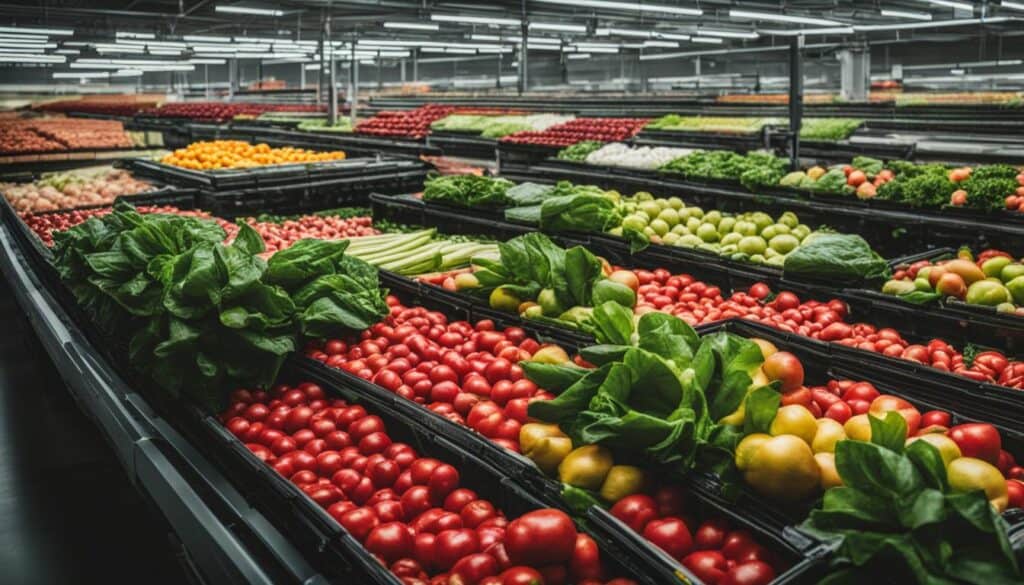
I believe that embracing digital technologies is crucial for the future of fresh produce logistics. By leveraging innovative solutions, we can overcome challenges, reduce waste, and ensure the highest quality of fruits and vegetables for consumers.
Overall, the fresh produce logistics sector faces various challenges, including waste reduction, quality regulations, and maintaining a positive business reputation. However, with the implementation of cutting-edge technologies and the adoption of sustainable practices, the industry is well-positioned to meet the evolving demands of consumers while ensuring the efficient and safe transportation of fresh fruits and vegetables.
Suitable Vehicles for Fresh Fruit and Vegetable Transportation
When it comes to transporting fresh fruits and vegetables, it is crucial to choose suitable vehicles that can maintain the necessary temperature control and prevent spoilage. Refrigerated trucks and trailers, commonly referred to as reefers, are the ideal solution for this task.
Refrigerated trucks and trailers are specifically designed to transport perishable goods such as fruits and vegetables. They are equipped with temperature-controlled systems that ensure the produce remains at the optimal temperature throughout the entire journey.
Benefits of Refrigerated Transportation
- Preserves Freshness: Refrigerated trucks and trailers maintain the freshness and quality of the fruits and vegetables by providing the necessary temperature control.
- Reduces Food Waste: Proper transportation in reefers helps reduce food waste by preventing spoilage due to temperature fluctuations.
- Minimizes Greenhouse Gas Emissions: By using refrigerated transportation, we can significantly reduce greenhouse gas emissions associated with food waste.
Reefers play a crucial role in the fresh produce supply chain by ensuring the quality and freshness of the fruits and vegetables reach the consumers. They not only protect the produce but also contribute to sustainability efforts by reducing waste and minimizing environmental impact.
Impact on Greenhouse Gas Emissions
“Utilizing refrigerated transportation for fresh produce is not only beneficial for maintaining quality and freshness but also has a positive impact on greenhouse gas emissions. By preventing spoilage and reducing food waste, we can significantly decrease the carbon footprint of the food supply chain.”
With the increasing awareness of environmental sustainability, using refrigerated trucks and trailers for fresh produce transportation is the responsible choice. By investing in proper transportation methods, we can ensure that consumers receive high-quality fruits and vegetables while minimizing waste and environmental harm.
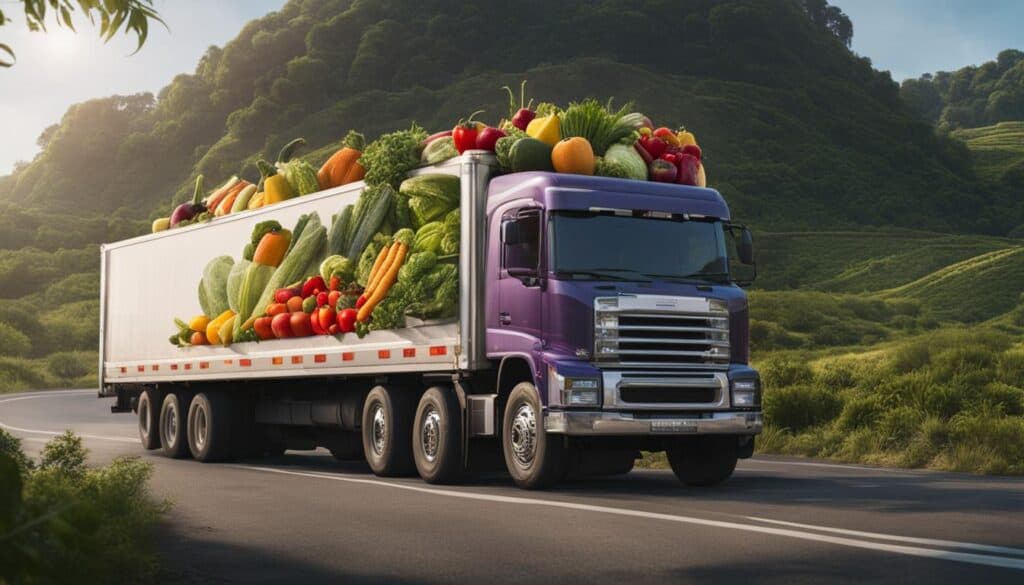
Packaging Guidelines for Fresh Produce
When transporting fresh produce, proper packaging is crucial to protect it during transit and minimize damage. The right packaging materials and techniques can help ensure that fruits and vegetables reach their destination in optimal condition. Here are some guidelines to follow:
1. Consider the Type of Produce
Different types of produce require specific packaging considerations. Sturdy fruits with hard skins, such as apples or oranges, are easier to transport and can withstand more handling. However, softer fruits like berries or peaches require extra care to prevent crushing or bruising. When packaging softer fruits, use cushioning materials like foam or packing paper to provide additional protection.
2. Choose Suitable Packaging Materials
Select packaging materials that can absorb shocks and vibrations during transportation. Plastic pallets or wooden crates are commonly used for their durability and ability to withstand rough handling. These materials provide a stable base and offer protection against impacts that could damage the produce. Additionally, consider using dividers or trays within the packaging to prevent excessive movement and potential damage.
3. Optimize Packaging Efficiency
Efficiency in packaging can help minimize damage and reduce waste during transportation. Pack produce tightly to prevent shifting and provide structural integrity to the package. Use appropriate cushioning and fillers to fill any empty spaces and prevent movement within the packaging.
4. Take Sustainability into Account
As the demand for sustainable packaging options increases, consider using environmentally friendly materials when possible. Recyclable and biodegradable packaging options help minimize waste and promote sustainability within the fresh produce industry. Look for packaging solutions made from renewable resources or those that can be easily recycled.
5. Follow Labeling Requirements
Ensure that your packaging adheres to labeling requirements set by regulatory bodies. Proper labeling makes it easier to identify the type of produce, its origin, and any necessary handling instructions. This information is essential for efficient transportation and helps prevent mishandling or improper storage, which could affect the quality and freshness of the produce.
By following these packaging guidelines, you can protect fresh produce during transit, minimize damage, and contribute to sustainable practices within the industry.
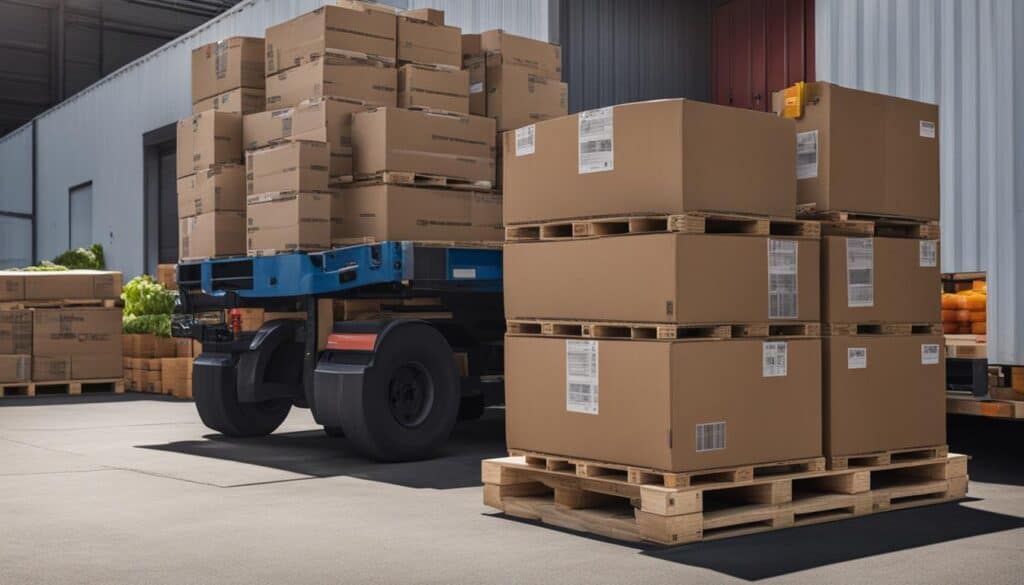
| Benefits of Proper Packaging | Sustainable Packaging Options |
|---|---|
| – Minimizes damage during transportation | – Recyclable packaging materials |
| – Protects freshness and quality | – Biodegradable packaging materials |
| – Reduces likelihood of bruising or crushing | – Packaging made from renewable resources |
| – Facilitates efficient handling and storage | – Compostable packaging options |
Conclusion
In conclusion, proper transportation is of utmost importance when it comes to transporting fruits and vegetables. It not only ensures the freshness and quality of the produce but also reduces waste and helps maintain a good business reputation. One of the key aspects of effective fruit and vegetable transportation is the use of refrigerated transport, commonly known as reefers, which plays a vital role in preserving the produce’s quality and safety.
Looking ahead, future trends in fresh produce logistics focus on sustainability and digitization. As consumer demands for environmentally-friendly practices increase, businesses are striving to adopt more sustainable transportation methods and packaging practices. Additionally, the digitization of the food supply chain is gaining momentum, offering improved visibility, resilience, and efficiency in fresh produce logistics.
By investing in quality transportation and packaging practices, businesses can ensure that their fruits and vegetables reach consumers in peak condition. This not only benefits the overall supply chain but also meets the growing demands of health-conscious consumers who value fresh and high-quality produce. It is crucial for the industry to embrace these future trends and continue to innovate in order to thrive in the ever-evolving market of fresh produce logistics.
FAQ
What are the challenges of shipping fruits and vegetables?
The challenges of shipping fruits and vegetables include timely processing and shipping, natural delays, short shelf life, and communication difficulties.
How should fruits and vegetables be packaged for shipping?
Fruits and vegetables should be packaged in cartons made from fibreboard with proper ventilation holes. Additionally, packages should be labeled according to regulatory requirements.
What is the role of reefers in fruit and vegetable transportation?
Reefers, or refrigerated trailers, are essential for temperature-controlled transportation of fruits and vegetables. They maintain proper temperature and ventilation to ensure freshness and safety during transit.
What is the importance of temperature control in fruit and vegetable shipping?
Temperature control is crucial in fruit and vegetable shipping to maintain freshness and quality. Different types of produce require specific temperature ranges for optimal storage.
What are the challenges and developments in fresh produce logistics?
Challenges in fresh produce logistics include reducing waste, adhering to quality regulations, and maintaining a good business reputation. Developments focus on trends such as digitization of the food supply chain.
What are suitable vehicles for fresh fruit and vegetable transportation?
Refrigerated trucks and reefer trailers are the most suitable vehicles for transporting fresh fruits and vegetables. They provide temperature control and help reduce greenhouse gas emissions and food waste.
What are the packaging guidelines for fresh produce?
Proper packaging is crucial for protecting fresh produce during transit. Sturdy fruits with hard skins are easier to transport, and suitable packaging materials such as plastic pallets or wooden crates can absorb shocks and vibrations. Sustainable packaging options are becoming increasingly desirable.

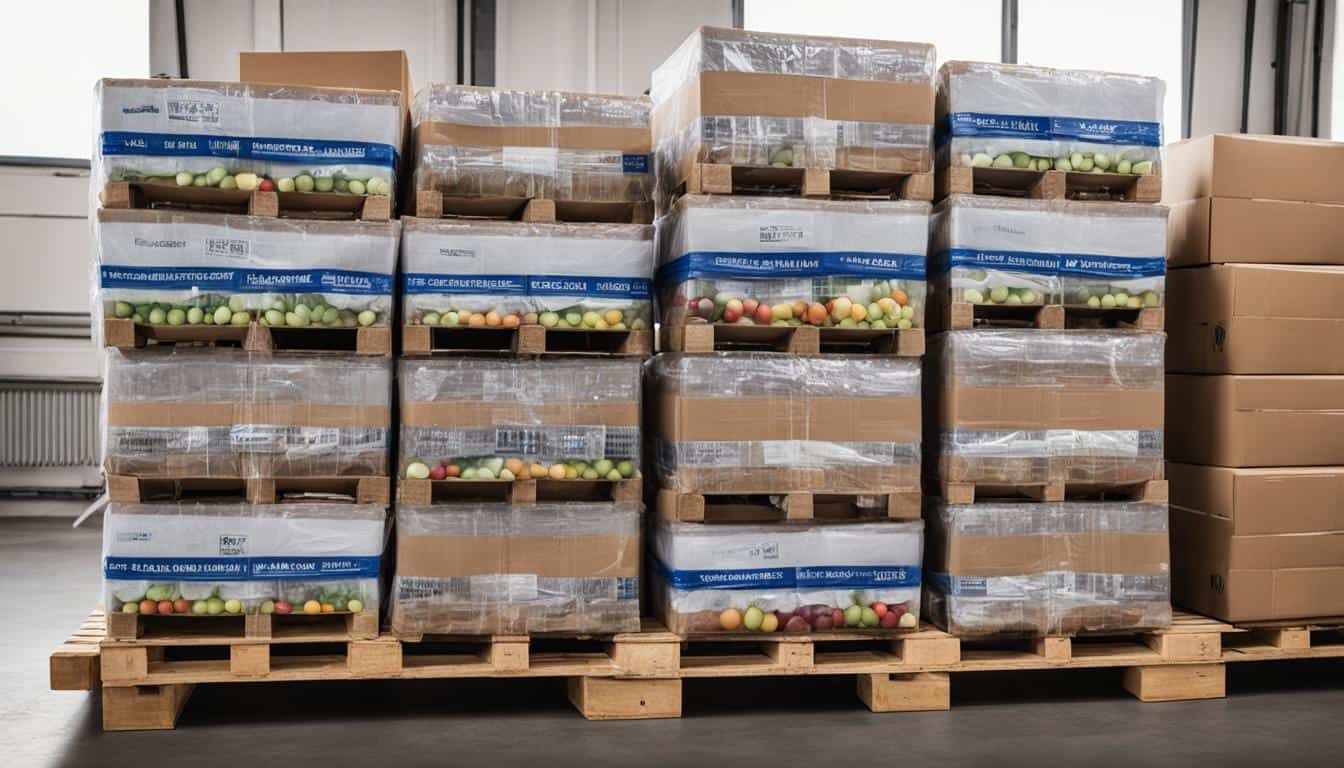



Leave a Reply